The Microsoft Lumia 640 Review
by Brandon Chester on June 9, 2015 8:00 AM EST- Posted in
- Smartphones
- Microsoft
- Mobile
- Lumia
- windows phone 8
System Performance
Since the state of benchmarking on Windows Phone is not as mature as Android, I haven’t been able to compare the Lumia 640 to the competition in every aspect that I would like to. What I have been able to do is put it through our standard browser benchmarks, along with BaseMark OS II to look at individual component performance, and GFXBench to examine GPU performance.
While the absolute performance of Snapdragon 400 is well known, certain aspects of performance are heavily impacted by a device’s software. A good example is browser performance, which is a function of both SoC power and the speed of a device’s browser and Javascript engine. Two devices with the same SoC can have very different browser performance.
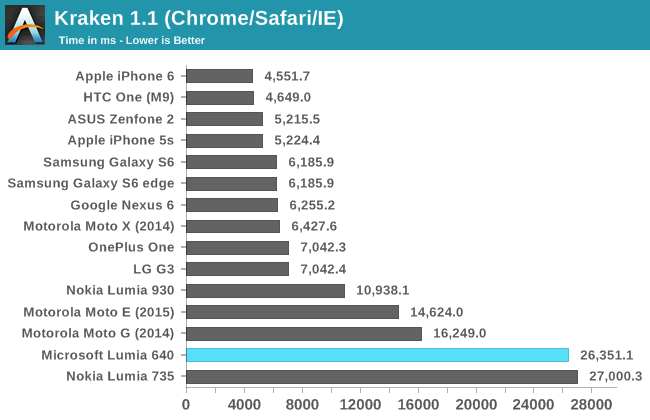
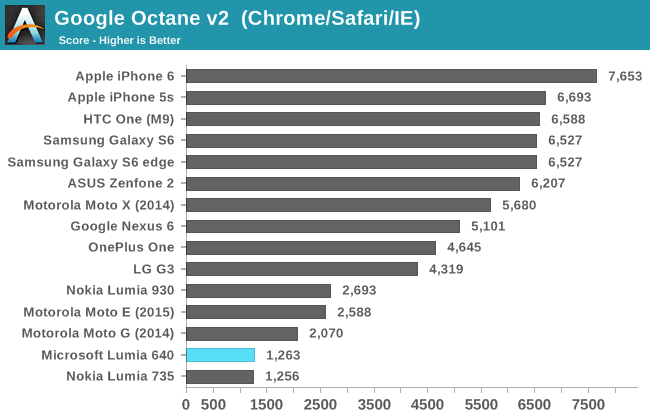
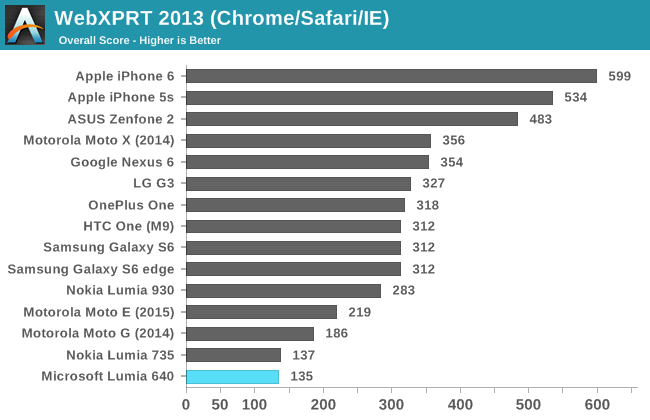
Unfortunately, it’s clear that Internet Explorer doesn’t measure up to Chrome and Safari when it comes to performance. While buyers may be pleased that their Lumia 640 performs as well as the more expensive Lumia 735, both of these phones occupy the lowest positions on every chart. There’s even a significant gap between them and other Snapdragon 400 devices running Android, such as Motorola’s Moto G.
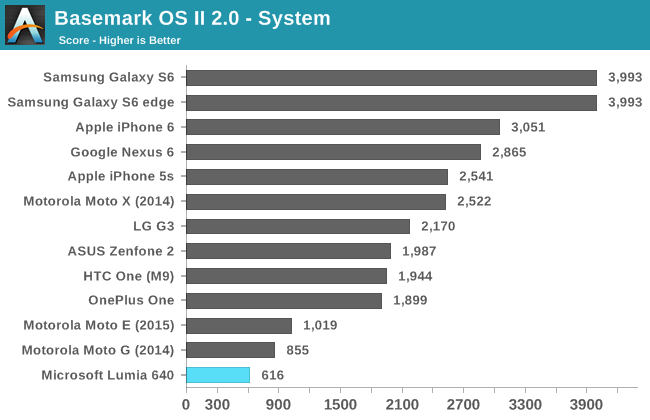
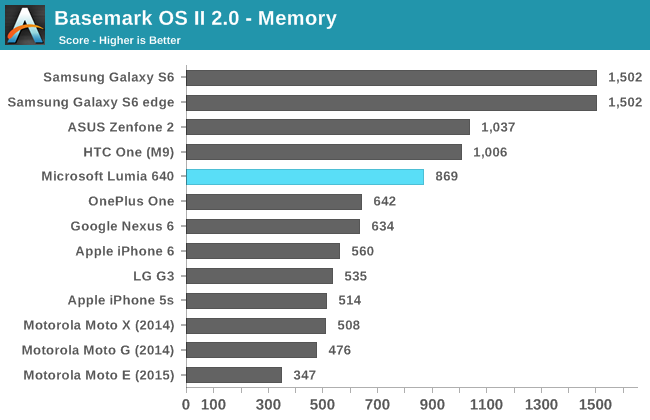


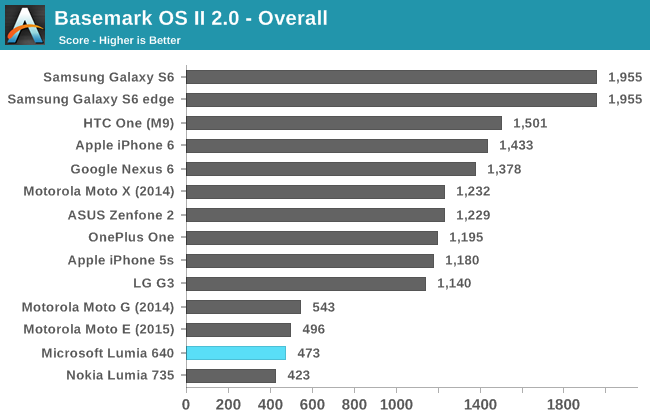
There's not much need to go into detail on the Lumia 640's performance in BaseMark OS II. With the exception of a fairly good result in the NAND memory test, the Lumia 640 achieves the lowest scores that we've seen in recent times.
Unfortunately, the Lumia 640 isn't shaping up to be a very quick device. It's consistently bested by Snapdragon 400 devices running Android, and in 2015 we're going to see Snapdragon 410 used as the SoC of choice in devices at this price bracket, which won't make the Lumia 640's position any better. Microsoft needs to iterate much quicker than they currently are. Their slow pace in adoption new hardware helped kill Windows Phone in the high end market, and it will do the same to the low end. I have some further words about performance on the Lumia 640 and Windows Phone in general, but those will have to wait until the software section of the review.
GPU Performance
The last area of performance to investigate is GPU performance. The performance of Adreno 305 has been thoroughly evaluated on Android, but differences in drivers and graphics APIs can improve or reduce performance across different operating systems.
Since Adreno 305 doesn’t support Direct3D feature level 10.0 and Shader Model 4.0 it’s unable to run the GFXBench 3.0 Manhattan test. This leaves us with only the T-Rex HD benchmark which isn’t very hard on high end devices, but still poses quite a challenge for weaker mobile GPUs.
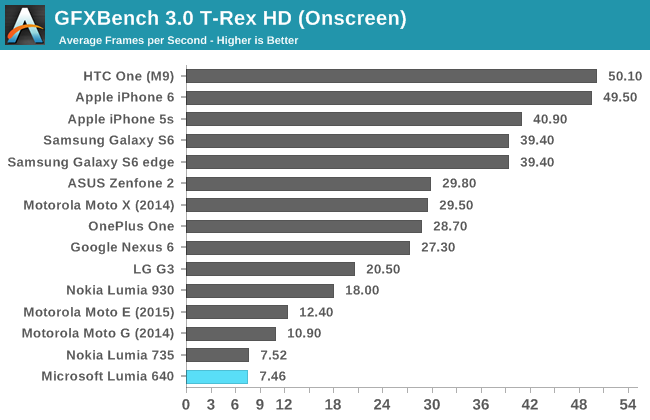
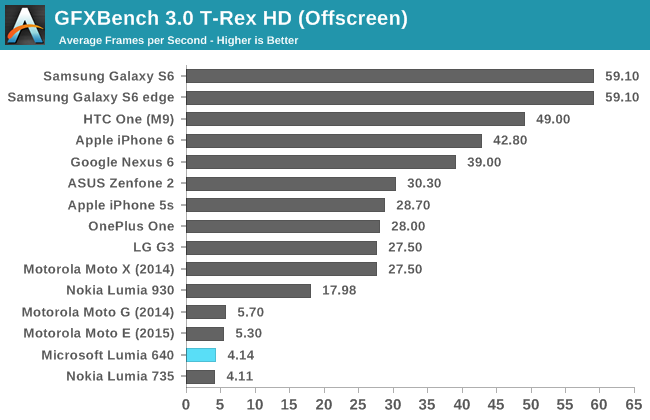
In both the on-screen and off-screen tests, the Lumia 640 lags behind the Moto G. While 1-2fps doesn’t seem like much, when your frame rate is in the low single digits it represents a significant difference in performance. Because of this, I decided to take a look at the performance in GFXBench’s driver overhead test to see what impact the GPU drivers and graphics API might have on performance.
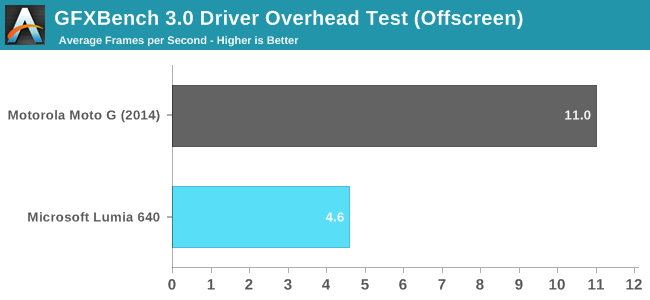
As suspected, there’s a very significant gap in performance when comparing the Lumia 640 to the Moto G. I can’t say whether this is due more to the differences between OpenGL and DirectX, or between the different Adreno drivers on Windows Phone and Android, but whatever the case may be the end result is a notable decrease in GPU performance on Windows Phone when compared to an Android device with the same SoC.
I’m not happy at all with the GPU performance that we see in low-end and even mid-range smartphones, and the Lumia 640 is no exception. There’s not much Microsoft can do here though, as moving to Snapdragon 410 with its Adreno 306 will not improve GPU performance at all. All I can really say is that users shouldn’t expect to be playing any 3D games on their Lumia 640, but simpler 2D games should run just fine.










130 Comments
View All Comments
testbug00 - Tuesday, June 9, 2015 - link
Just one FYI, Glance has multiple modes, including "peek" where it only activates when it detects something moving over it (or leaving a space where it always is 'sensing' something (IE, a pocket)And, yeah. Windows Phone uses a lot of battery life to have Wifi on. Dunno why. Even without any MS account on it and no non-native apps it still eats 2-2.5% of battery on 920. Haven't tested on other WP devices.
BrokenCrayons - Tuesday, June 9, 2015 - link
Nice phone for a good price, but it's positively huge with a 5 inch screen. Its disappointing that it's impossible to find a phone with decent specifications and a 3.5 inch screen. I can't imagine carrying this or any other phone that big around. I'd be tempted to tape a stick to it and use it as an oar.kyuu - Tuesday, June 9, 2015 - link
As someone whose smartphone history is iPhone 4, Lumia 920, and now Lumia 1520, I can tell you that once you've used a bigger smartphone (1520 has a 6" screen), you cannot go back to the small ones. They feel like toys and browsing the internet or watching videos on them is intolerable.Daniel Egger - Tuesday, June 9, 2015 - link
Get a 735 then. It's a very nice piece and noticeably smaller than the 640 plus it has an AMOLED display. It's a bit larger than my 820 which for me has about the perfect screen size but it's thinner and much lighter (especially since it has Qi built-in rather than needing a special cover which adds additional bulk and weight).MrSpadge - Tuesday, June 9, 2015 - link
Consider the Lumia 435 then. Internally it's not much different from the 640 if you can live with a few compromises.paulheu - Tuesday, June 9, 2015 - link
Google does not just not make any apps for Windows Phone, it actively blocks anyone else from doing the same if at all possible. Hopefully with Windows 10 this will change due to the very nature of that OS . We'll see..The remarks on Glance probably come from not having the extension app loaded which allows for backgrounds and more options.
Brandon Chester - Tuesday, June 9, 2015 - link
The Glance Screen app doesn't show up in the store for all Windows Phones, Lumia 640 included. If you look at the list of Microsoft apps when browsing the store on the phone it's just not even there.MATHEOS - Tuesday, June 9, 2015 - link
You definitely should have rating system!atata - Tuesday, June 9, 2015 - link
I've had this phone for several months and it feels great after Lumia 525. I certainly don't see the battery drain mentioned in this review, but I don't use most of fancy mobile apps aside from Viber.lilmoe - Tuesday, June 9, 2015 - link
"Microsoft's scroll speed cap also makes the entire operating system feel slow"This issue is so underrated, and I believe (even with your criticism) that you were very diplomatic in your complaint. This is BY FAR my biggest issue with Windows Phone and I've nagged Microsoft so many times on uservoice and the feedback app about the speed of scrolling and inertia settings (speed and feel of the "flick"). Not only does it feel slow, it's also not even close to being natural.
iOS is slower than my liking too, but it feels more natural in a sense. I believe Samsung got the speed and the "flick" right with their devices, and Android followed after JellyBean. Microsoft needs to blatantly copy Android in that department, and screw what people say.